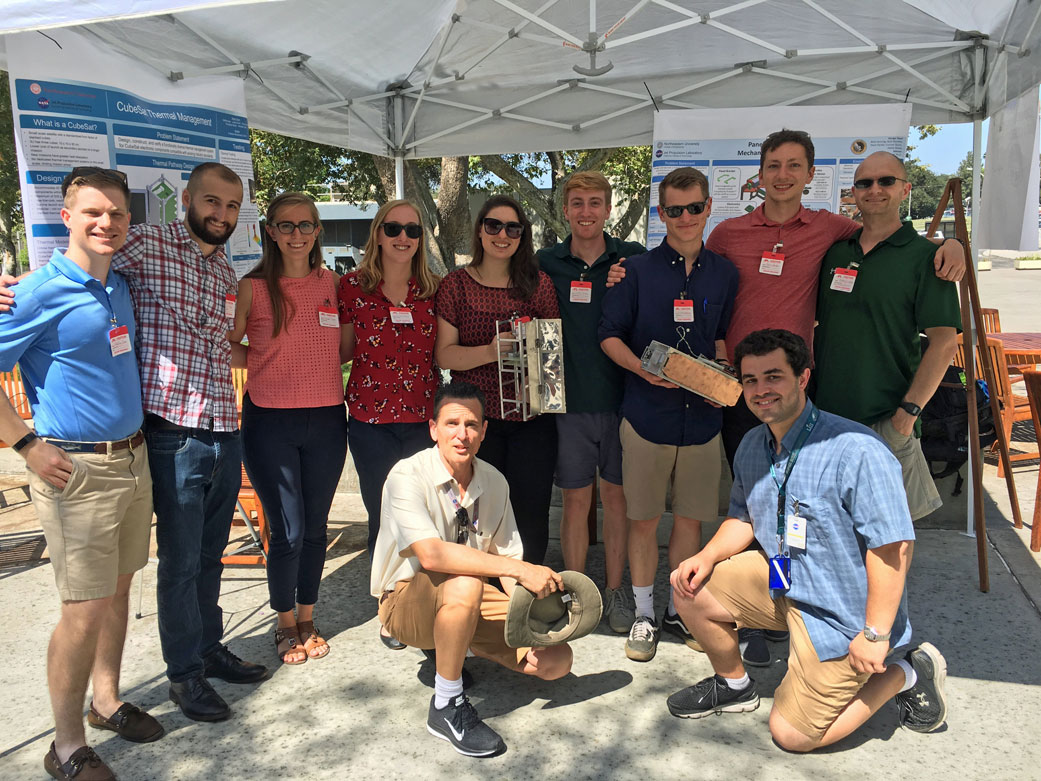James Smith created the JPL University Crowdsourcing Initiative (JUCI) to pair JPLers with a volunteer workforce hungry for challenges.
It was 2016 and Alex Austin couldn’t believe his luck. A college senior studying aerospace and mechanical engineering at New York’s Rensselaer Polytechnic Institute, he had been working hard with his classmates on a challenge presented by NASA’s Jet Propulsion Laboratory to design a miniature satellite that could capture orbital debris. Then his professor shared some news: Austin’s group had been selected to fly out to JPL in Southern Calfornia and present their design to Lab experts.
“We just thought it was the coolest thing ever,” says Austin, now the lead engineer for JPL’s Team Xc, a team of engineers who formulate potential missions involving two types of miniature satellites known as CubeSats and smallsats. “I mean, we were a bunch of undergrad engineering students, and now these real engineers were going to review our work.”
The opportunity was a unique and relatively new one at the time, thanks to Architecture and Formulation Group Supervisor and JUCI Program Manager James Smith, who created the JPL University Crowdsourcing Initiative (JUCI) in 2013 with one goal in mind: to pair JPLers and their ideas with a volunteer student workforce looking to connect and engage with JPL projects.
How It Works
JUCI works in three steps: A JPLer proposes a challenge in 100 words or less that is emailed to partner universities; universities express interest and then the JPLer selects one or more universities to pair with; and the university provides the work, with JPLers providing approximately two hours of mentorship and coaching per month.
After Austin made his way to JPL and presented his concept with his fellow students – “We were so formal about it all, wearing our ties and coming in with a 50-slide presentation,” he recalls with a laugh – he was so enthralled by the experience that he knew JPL was the place for him.
The CubeSat has yet to fly, but Rensselaer Polytechnic Institute continues to develop it with its next class of students. As for Austin, he found an even more rewarding outcome.
“JUCI gave me the connections at JPL to get an internship and later a full-time job,” he says. “I was always a giant space nerd. To me, there was nowhere cooler to work. I always knew about JPL but I had no involvement with it really until [JUCI]. After the program, I still didn’t think I’d end up working here – it always seemed like a dream – but it was the first step that got me in the door to make the connections to get me to where I am today.”
For Smith, seeing a career dream come true for Austin – alongside the maturation of JPLers’ ideas – is exactly why he started JUCI.
“I created JUCI to make it a platform accessible to anyone and everyone to get help with a task or explore an idea,” Smith says. “JUCI connects JPLers with volunteer student teams to mature their idea with no proposal writing, no proposals to review, no contracts, and there’s no funding exchanged.”
Spirit of Collaboration and Inclusion
While JUCI can lead to students gaining internships at JPL, the reverse is also true: When their internships are ending, current interns paid through JPL’s human relations or Communications and Education directorates can extend their connection to the Lab by working on a voluntary basis through the JUCI program.
Perhaps the most important aspect of the program is its spirit of collaboration and inclusion.
“Better solutions come from a more broad community of ideas,” Smith says. “Over half of our points of contact are at minority-serving institutions. I’m part of the Lab’s Inclusion Advisory Committee, and DE&I is very important to me. I want to expand our network and bring in a diverse workforce, and I want to identify and grow the next generation of industry leaders while serving the Lab.”
If some of the success stories so far are any indication, JUCI will have great potential for years to come.
Dozens of studies have been performed to date, allowing JPLers to explore advanced mission concepts, mature technology, and perform trade studies and science research and analysis. Some mission concepts and projects that thrived thanks to the program include: the Venus Wind Turbine with California State University, Los Angeles; a coilable boom with University of Colorado, Boulder; and Shapeshifter, an award-winning multifunctional unmanned aerial-terrestrial vehicle for extra-planetary exploration with the University of Buffalo.
Smith also points out that a long-standing JUCI relationship with California State Polytechnic University, Pomona facilitated the capture of funding for development of a CubeSat program at the school, which is currently being leveraged through JUCI to flight-demonstrate additively manufactured heat rejection systems that will benefit future missions.
While many of the challenges past and present are engineering-focused, Smith emphasizes that JUCI exists for any JPLer to submit any challenge – from robotics to external communications or business administration – and connect with a network of students in a variety of disciplines eager to help them with their project. The program has a network of more than 80 schools, but Smith hopes that, as more JPLers take advantage of JUCI, the potential talent pool can grow even larger as a wider variety of challenges attracts a wider variety of schools, disciplines and students.
“I really want folks to look at this and think, ‘Wow, I’ve had this idea burning in my head for so long and finally there’s a mechanism that will help me explore it,’” Smith says. “I just want people to use it, so their creativity is leveraged and not lost. It’s been a labor of love.”
Melissa Pamer
Jet Propulsion Laboratory, Pasadena, Calif
626-314-4928
melissa.pamer@jpl.nasa.gov
Written by Celeste Hoang


























